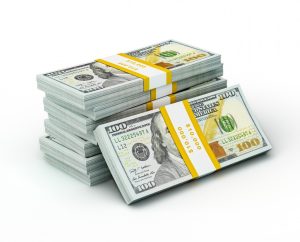DOLLAR TRADES HIGHER AFTER FED, INVESTORS FOCUS ON ISRAEL-IRAN CONFLICT
The U.S. dollar traded higher against most major currencies on Wednesday, but remained weaker against the yen after the Federal Reserve kept interest rates unchanged as economic uncertainty and tariffs continue to paint a murky outlook. Policymakers still forecast slashing rates by half a percentage point this year, but have slowed the pace of future cuts, concerned that President Donald Trump’s tariffs would stoke inflation. “The speculation continues to be up in the air. Q2 numbers are going to be key to really coming to the realization that we are under actual recessionary pressures that will force the Fed to really rethink what they’re doing,” said Juan Perez, director of trading, at Monex USA. “They are receiving mixed signals, so they’re sending back mixed signals.” With the Fed’s decision now behind it, markets remain focused on the fighting between Israel and Iran, which has spurred investors to scoop up safe havens. Israel has bombarded arch-enemy Iran over the past six days to halt its nuclear activity and has asserted the need for a change of government in the Islamic Republic. The U.S. military is also bolstering its presence in the region, Reuters reported, stirring speculation about U.S. intervention that investors fear could widen the conflict in an area with critical energy resources, supply chains and infrastructure. Iranian Supreme Leader Ayatollah Ali Khamenei has rejected Trump’s demand for unconditional surrender on Wednesday, and the U.S. president said his patience had run out but gave no clues on his next step. The dollar has resumed its role as a haven, having gained around 1% against both the Japanese yen and Swiss franc since last Thursday. On Wednesday, the U.S. currency took a breather, edging fractionally lower against the yen and the franc and more noticeably so against the euro and the pound. Against a basket of six other major currencies, the dollar is still down around 8% so far this year as confidence in the U.S. economy and the reliability of Trump’s administration as a trading and diplomatic partner have faded. Against the yen, the dollar pared losses and was last seen down 0.06% to 145.18 and was 0.36% higher against the franc at 0.8190 francs.
DOLLAR TRADES HIGHER AFTER MIXED US DATA, BUT MIDEAST CONFLICT KEEPS MOOD TENSE
The U.S. dollar pared losses to trade firmer on the yen on Tuesday, after economic data showed American consumers growing more cautious as trade and inflation uncertainty lingered ahead of the Federal Reserve’s decision on interest rate later this week. U.S. retail sales were softer than expected in May, but consumer spending remained supported by solid wage growth. The dollar initially softened on the print, but quickly reversed those loses as the market digested the data’s mixed picture, removing strength the yen had gained following the Bank of Japan’s (BOJ) rate decision earlier. “The weaker headline retail sales release and last week’s softer CPI print add more fuel to rate cut speculation, including calls from (U.S. President) Trump for a 100-bps cut,” said Uto Shinohara, senior investment strategist at Mesirow Currency Management. “However, the full inflationary impact of tariffs has yet to pass through.” Broader risk sentiment remained fragile with the Israel-Iran conflict entering its fifth day. The BOJ delivered little surprise to markets at the conclusion of its two-day monetary policy meeting, as it stood pat on rates and laid out a new plan to decelerate the pace of its balance sheet drawdown next year in the face of rising risks such as the Middle East conflict and U.S. tariffs. The yen swung between losses and gains after the decision, turning negative during Governor Kazuo Ueda’s press conference, with the dollar last up 0.25% on the yen at 145.17 yen. Japanese Prime Minister Shigeru Ishiba and U.S. President Donald Trump have yet to reach a trade deal. Developments in the Middle East are keeping the mood tense, with Trump on Tuesday saying he wanted a “real end” to the nuclear dispute with Iran, and indicating he may send senior American officials to meet with the Islamic Republic. It follows news on Monday from the White House that Trump left the Group of Seven summit in Canada a day early due to the situation in the Middle East, as the president has requested that the National Security Council be prepared in the situation room.
DOLLAR FIRMS AS MIDEAST WORRIES CAST SHADOW, NORGES BANK DELIVERS SURPRISE CUT
The dollar edged up on Thursday as the threat of a broader Middle East conflict loomed over markets, while a flurry of central bank decisions, including a surprise cut from Norway kept traders busy. Rapidly rising geopolitical tensions have boosted the dollar, which has reclaimed its safe-haven status in recent days. The Reuters Daily Briefing newsletter provides all the news you need to start your day. Sign up here. Iran and Israel carried out further air attacks on Thursday, with the conflict entering its seventh day. Concerns over potential U.S. involvement have also grown, as President Donald Trump kept the world guessing about whether the United States will join Israel’s bombardment of Iranian nuclear sites. The Federal Reserve left rates steady on Wednesday. The Bank of England also left rates unchanged on Thursday, citing elevated global uncertainty and persistent inflation as concerns for the economic outlook. The pound fell initially but later recouped most of those losses. The Swiss franc, meanwhile, was stronger against the dollar following an expected rate cut from the Swiss National Bank. But the surprise came from the Norges Bank, which delivered a 25-bps rate cut, while markets had expected the Norwegian central bank to hold rates. The dollar and the euro both surged against the Norwegian crown and were last up 1% and 0.7% < EURNOK=D3>. The crown is still one of the top-performing major currencies against the dollar this year, with a gain of around 11%. Meanwhile, the euro held in negative territory at $1.1484. The dollar rose 0.3% against the yen to 145.62. The dollar index, which measures the currency against six others, was flat at 98.9 and was set for about a 0.8% gain for the week, its strongest weekly performance since late February. Some analysts said investors were looking to cover their short-dollar positions. “The dollar seems ripe for a short-covering rally – especially if the U.S. wades into the Middle East conflict,” said Matt Simpson, a senior analyst at City Index. U.S. markets are closed on Thursday for the federal Juneteenth holiday, which could mean liquidity is lower.
STERLING SET FOR WEEKLY LOSS AS MIDDLE EAST CONFLICT OVERSHADOWS DOMESTIC DATA
Sterling gained slightly against the dollar on Friday but was set for a loss on the week as uncertainty over the Israel-Iran conflict fuelled demand for traditional safe havens such as the greenback. Weak UK retail data earlier in the session and the Bank of England’s decision on Thursday to keep rates unchanged had little effect on the pound. The Reuters Daily Briefing newsletter provides all the news you need to start your day. Sign up here. Sterling was 0.2% higher at $1.3495 but eased 0.6% against the dollar on the week, after two consecutive weeks of gains. The dollar was set for its biggest weekly rise in more than a month on Friday. The BoE said it was monitoring risks from a weaker labour market and higher energy prices on the back of the conflict as it held interest rates at 4.25% as expected on Thursday, sending the pound down briefly against the U.S. dollar. “The pound was only lightly touched by a consensus Bank of England hold yesterday,” ING FX Strategist Francesco Pesole wrote in a note to clients. “Yesterday’s 6-3 vote split for a cut can be interpreted marginally on the dovish side and is allowing markets to reinforce their conviction call on an August cut.” Markets now priced in a near-60% chance for a quarter-point cut at the BoE’s next policy meeting. The euro was marginally up to 85.43 pence on Friday, set for its second week of gains in a row. Sterling briefly pared some earlier gains against the U.S. dollar after weak British retail sales data, which saw volumes recording their sharpest drop since December 2023 last month, as demand fell after shoppers splurged on food, summer clothes and home improvements the month before. “Retail sales in May brought significant payback” after a “hard to explain” strength in the previous four months, Allan Monks, chief U.K. economist at J.P. Morgan, said. The figures came alongside government borrowing figures which showed a slightly larger than expected budget deficit of 17.7 billion pounds ($23.88 billion) for May.
STERLING SLIPS AHEAD OF BANK OF ENGLAND DECISION; MIDDLE EAST IN FOCUS
Sterling slipped versus a stronger dollar on Thursday ahead of the Bank of England’s policy decision, with no change to rates the widely expected outcome, while investor sentiment remained fragile given the flaring conflict in the Middle East. At 0618 GMT the pound was 0.24% lower at $1.339 and unchanged against the euro, which held at 85.515 pence. The dollar strengthened after the Federal Reserve held rates steady as expected on Wednesday, and amid a surge in safe haven demand as a conflict in the Middle East continues and President Donald Trump weighs U.S. involvement. Traders are betting the BoE will follow suit in keeping rates steady on Thursday, even as the UK’s economic growth is faltering and inflation cooled slightly in May. The chance of no change stands at 96% with a tiny chance of a 25 basis point rate cut. Attention will be on the voting, after last month’s surprise three-way split among policymakers. A Reuters poll last week of 60 economists found that all of them expect the BoE to keep rates at 4.25% in June and almost all forecast a quarter-point rate cut in August. A jump in the price of oil during the ongoing Israel-Iran conflict presents another problem for the central bank to grapple with, as it could keep inflation higher. The pound has slipped more than 1% since last Thursday, but it remains 7% higher against the greenback in 2025, helped by a rush away from U.S. assets spurred by heightened trade uncertainty in light of Trump’s tariffs. Also helping out is the fact that the UK is the only country to have struck a trade deal with the United States. Trump and British Prime Minister Keir Starmer finalised the deal at the G7 summit this week.
- CAPITALDIGEST MARKET REVIEW , 03/11/2025November 3, 2025
- CAPITALDIGEST DAILY NEWS, 03/11/2025November 3, 2025
- CAPITALDIGEST MARKET REVIEW, 22/09/2025September 22, 2025
Enter your email address for receiving valuable newsletters.
- CAPITALDIGEST DAILY NEWS, 03/11/2025NNPCL WEIGHS OVERHAUL, REPURPOSING OPTIONS FOR REFINERIES The Nigerian National Petroleum Company Limited has said...November 3, 2025
- CAPITALDIGEST MARKET REVIEW, 22/09/2025STERLING RISES AGAINST DOLLAR ON FED-BOE POLICY DIVERGENCE Sterling gained against the dollar on Tuesday,...September 22, 2025
- CAPITALDIGEST DAILY NEWS, 22/09/2025OIL REFORMS DRIVE $18.2BN DEALS – FG Nigeria’s oil and gas sector is experiencing a...September 22, 2025














